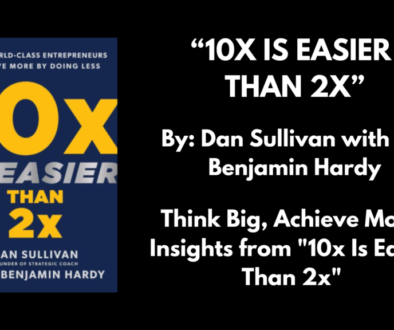Unlocking Efficiency with David Allen’s “Getting Things Done”
Last Updated on 27. Nov 2024 by b2bexport
Unlocking Efficiency with David Allen’s “Getting Things Done” (GTD) is a game-changer.
The Getting Things Done method is a structured time management and organizational system that provides a comprehensive roadmap to achieving stress-free productivity. Published in 2001, the book has become a cornerstone in the productivity genre, influencing countless professionals and enthusiasts.
This review aims to explore the core concepts, strengths, and potential limitations of Allen’s GTD methodology, providing a thorough understanding for those seeking to master their personal productivity.
The Philosophy Behind GTD
At the heart of GTD lies a simple yet profound philosophy: our minds are for having ideas, not holding them.
David Allen posits that the human brain is a brilliant processor but a poor storage device. The constant juggling of tasks, commitments, and ideas leads to mental clutter, stress, and decreased productivity.
By externalizing our tasks and organizing them systematically, we free our minds to focus on execution rather than memory.
The Five Steps of GTD
- Capture: The first step in the GTD process is to capture everything that requires your attention.This could be tasks, ideas, projects, or commitments. Allen emphasizes the importance of using a reliable system to gather these inputs, whether it be a notebook, a digital app, or a combination of both. The goal is to ensure that nothing slips through the cracks, thus reducing the mental burden of remembering every detail.
- Clarify: Once captured, each item needs to be clarified. This involves deciding what the item means and what action, if any, is required.Allen calls for asking questions like, “Is this actionable?” to ensure clarity and specificity. If yes, determine the next action; if no, categorize it as trash, reference material, or something to revisit later.
- Organize: After clarifying, it’s time to organize.This step involves categorizing tasks and information into appropriate lists. The main categories include:
- Next Actions: Specific tasks that can be done immediately.
- Projects: Multi-step outcomes that require more than one action.
- Waiting For: Tasks that are dependent on others.
- Someday/Maybe: Ideas and tasks that you might want to pursue in the future.
- Calendar: Time-specific tasks and appointments.
- Reflect: Regular reflection is crucial to maintaining an effective GTD system.Allen advocates for a weekly review where you update your lists, assess progress, and plan the upcoming week. This reflection ensures that your system remains current and aligned with your priorities.
- Engage: The final step is to engage, meaning to use your system to take appropriate actions.Allen introduces criteria for choosing tasks, including context, time available, energy levels, and priority. This decision-making process helps in selecting the right task at the right time, ensuring maximum productivity.
Applying GTD in Daily Life
David Allen’s GTD methodology is not just about getting things done; it’s about achieving stress-free productivity.
By utilizing digital tools and a trusted system, individuals can capture tasks efficiently and convert them into actionable items. The GTD workflow encourages a structured approach, helping to project forward and manage all the tasks with a clear mind.
This method is particularly effective for those who feel overwhelmed by the complex systems of traditional time management strategies.
The Impact of Weekly Reviews
A key element of the GTD system is the weekly review.
This practice allows you to process your to-do list, project list, and next actions, ensuring that you are on track with your long-term goals. Allen recommends organizing your tasks according to the current context and desired outcome, which helps in maintaining focus and mental energy. By dedicating time to these weekly reviews, you can control the open loops and ensure that your project plan aligns with your desired result.
David Allen’s “Getting Things Done” offers a life-changing approach to personal productivity.
By implementing the five stages of the GTD system, individuals can achieve a structured and stress-free way of managing their tasks and projects. Whether you are dealing with information technology projects or everyday to-dos, the GTD methodology provides the tools and techniques to get things done efficiently.
Embracing this system can lead to a complete transformation in how you manage your time, energy, and focus, ultimately leading to a more productive and fulfilling life.
By integrating the principles of GTD, you can unlock the potential for stress-free productivity and ensure that your personal and professional life runs smoothly. From capturing and clarifying tasks to organizing and engaging in the correct item at the right time, David Allen’s GTD method is a proven system that has helped hundreds of thousands of people worldwide.
Start your journey towards a more productive future today with GTD.
Strengths of the GTD System
Comprehensive Framework:
One of the standout features of the GTD methodology, created by David Allen, is its comprehensive nature. It covers the entire spectrum of productivity, from capturing ideas to executing tasks.
This holistic approach ensures that no aspect of personal productivity is overlooked.
Flexibility:
The GTD system is not a one-size-fits-all method. It provides a framework that can be tailored to individual needs and preferences.
Whether you prefer digital tools or analog methods, GTD can be adapted to suit your style, making it a versatile productivity methodology.
Stress Reduction:
By externalizing tasks and commitments, GTD significantly reduces mental stress.
Knowing that everything is captured and organized in a trusted system allows for greater focus and peace of mind, leading to stress-free productivity.
Encourages Regular Reflection:
The emphasis on regular reviews, such as the weekly review, ensures that your system remains dynamic and responsive.
This continuous improvement cycle keeps you aligned with your goals and responsive to changes, helping you project forward and manage your time efficiently.
Potential Limitations
Initial Complexity:
For newcomers, the GTD method can seem complex and overwhelming.
The sheer number of lists and the rigor required to maintain the system may deter some individuals from fully committing to it.
Time-Consuming Setup:
Setting up the GTD system requires a significant upfront investment of time.
Capturing all your tasks and organizing them into the appropriate categories can be daunting initially, leading to a feeling of being overwhelmed.
Maintenance:
Keeping the system updated and conducting regular reviews requires discipline.
For those who struggle with consistency, maintaining a GTD system might be challenging, as it demands regular attention to keep all the tasks in order.
Overemphasis on Task Management:
While GTD excels in task management, it may not sufficiently address higher-level goal setting and prioritization for some users.
Integrating GTD with other strategic planning methods may be necessary for a comprehensive productivity approach, focusing on both immediate tasks and long-term goals.
Practical Applications
Professional Life:
In a professional setting, GTD can enhance productivity by providing a clear framework for managing tasks and projects.
It is particularly beneficial for individuals juggling multiple responsibilities, such as managers and executives. The GTD system helps capture tasks, break them down into actionable items, and ensure they are completed efficiently.
Personal Life:
GTD is equally effective in personal life management.
From planning vacations to managing household chores, the system helps in organizing personal tasks efficiently. The structured approach ensures that nothing falls through the cracks, providing a sense of control and accomplishment.
Creative Projects:
For creatives, GTD provides a structure to manage the often chaotic flow of ideas and projects.
By capturing and organizing creative inputs, individuals can focus more on execution and less on managing their workflow. This method helps in maintaining mental energy and avoiding mental clutter, allowing for more creative output.
Integrating GTD with Technology
In the digital age, numerous tools and apps are available to support the GTD methodology.
Applications like Todoist, OmniFocus, and Evernote offer features that align well with GTD principles. These digital tools can enhance the efficiency of capturing, organizing, and reviewing tasks, making the system more accessible and manageable.
Using these tools can streamline the GTD workflow, helping users to implement the methodology effectively.
Personal Insights and Experiences
Implementing GTD in my own life has been transformative.
The initial setup was indeed challenging, but the benefits have far outweighed the initial investment. The most significant advantage has been the mental clarity achieved by offloading tasks from my mind to a trusted system.
The weekly reviews, although time-consuming, have become a ritual that ensures I stay on track and aligned with my goals.
One of the key insights from my experience is the importance of customization. While David Allen’s framework provides the foundation, tailoring the system to fit my specific needs and preferences has been crucial.
For instance, I have combined GTD with elements of time blocking and goal-setting frameworks to create a hybrid system that works best for me.
This approach has helped me to not only manage my immediate tasks but also to focus on long-term goals and desired outcomes, ensuring a balanced and effective productivity strategy. By integrating all the elements of the GTD system and using the right tools and methods, I have been able to achieve a higher level of productivity and maintain a stress-free mindset.
This experience has truly been life-changing, proving the power and effectiveness of the GTD methodology in both personal and professional contexts.

Unlocking Efficiency with David Allen’s “Getting Things Done” – Conclusion
David Allen’s “Getting Things Done: The Art of Stress-Free Productivity” is more than just a productivity book.
It embodies a comprehensive system known as the GTD method or GTD methodology that can transform how you manage your tasks and projects. This system, developed by David Allen of the David Allen Company, emphasizes capturing tasks, externalizing tasks, regular weekly reviews, and a structured approach to ensure all actionable tasks are addressed. The GTD system is renowned for its big ideas in personal productivity and time management, leveraging both digital tools and traditional methods to reduce mental clutter.
By organizing all your tasks into a trusted system and breaking them down into individual tasks and next actions, you can project forward with clarity.
Allen recommends organizing tasks based on their current context, allowing for a more focused and efficient workflow. Setting up and maintaining the GTD workflow requires effort, but the long-term benefits of mental clarity, reduced stress, and increased productivity make it a life-changing investment.
By mastering the five stages and key elements of GTD, such as the mind sweep, identifying actionable items, and conducting regular weekly reviews, you can effectively manage your to-do list, project list, and reference material.
For anyone seeking to improve their productivity in both professional and personal life, GTD offers a robust and adaptable productivity methodology. By integrating GTD principles, you can create a system that not only helps you get things done but also allows you to focus on what truly matters.
The transformation from feeling overwhelmed to achieving stress-free productivity is a testament to the effectiveness of the GTD method.
Embrace this structured approach to enhance your productivity, manage open loops, and achieve your desired outcomes. With GTD, you can convert tasks and projects into actionable steps, leading to significant improvements in how you handle your work and life.
As David Allen and Penguin Books have shown, the power of a well-organized system can be profound, helping you accomplish hundreds of thousands of tasks efficiently and effectively.




